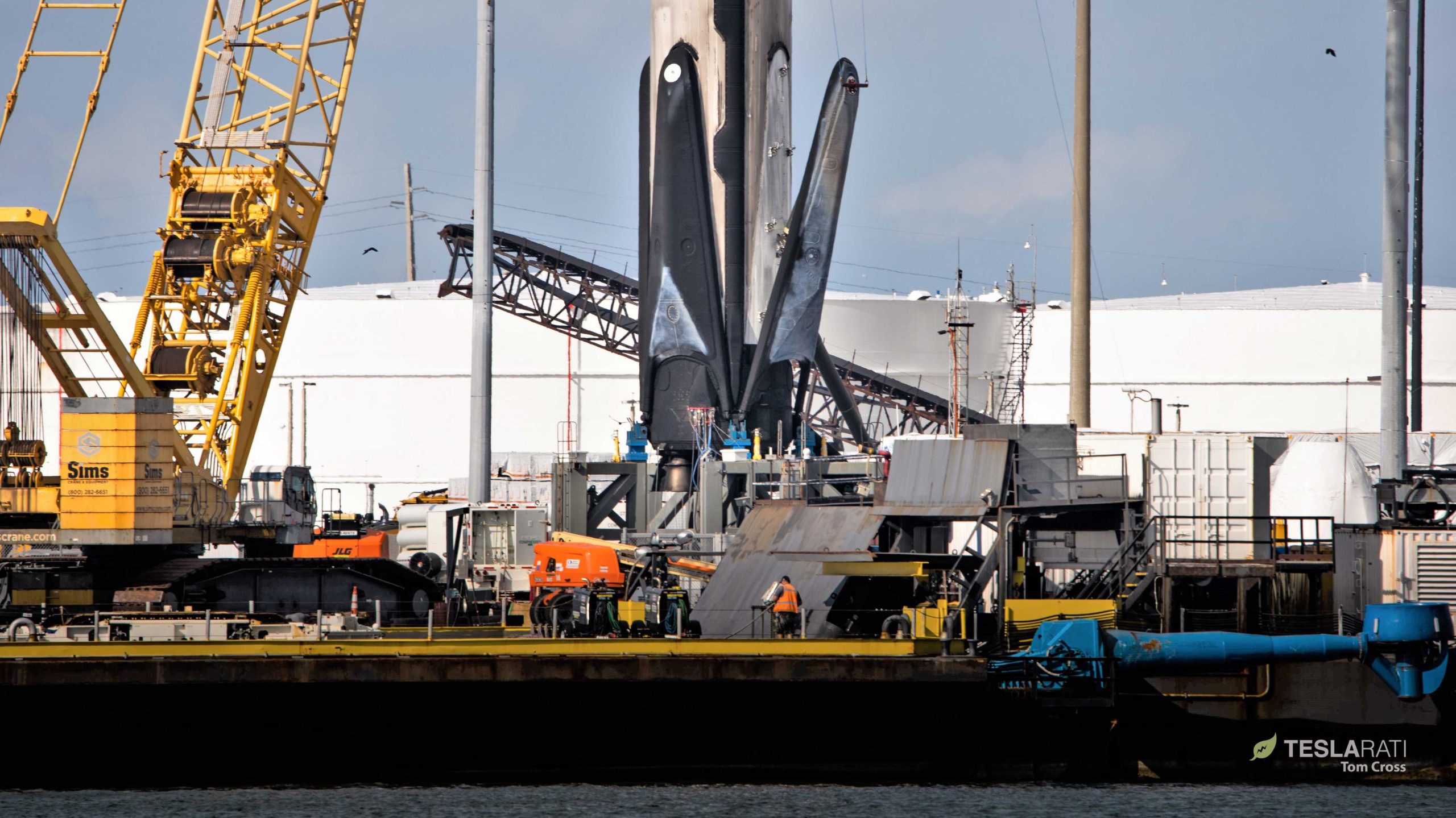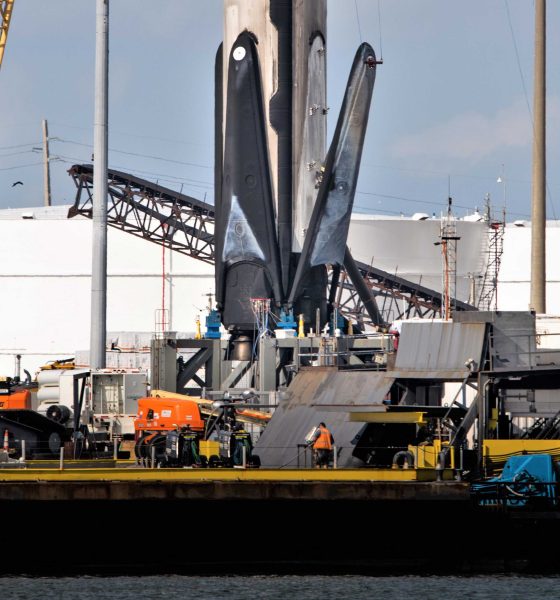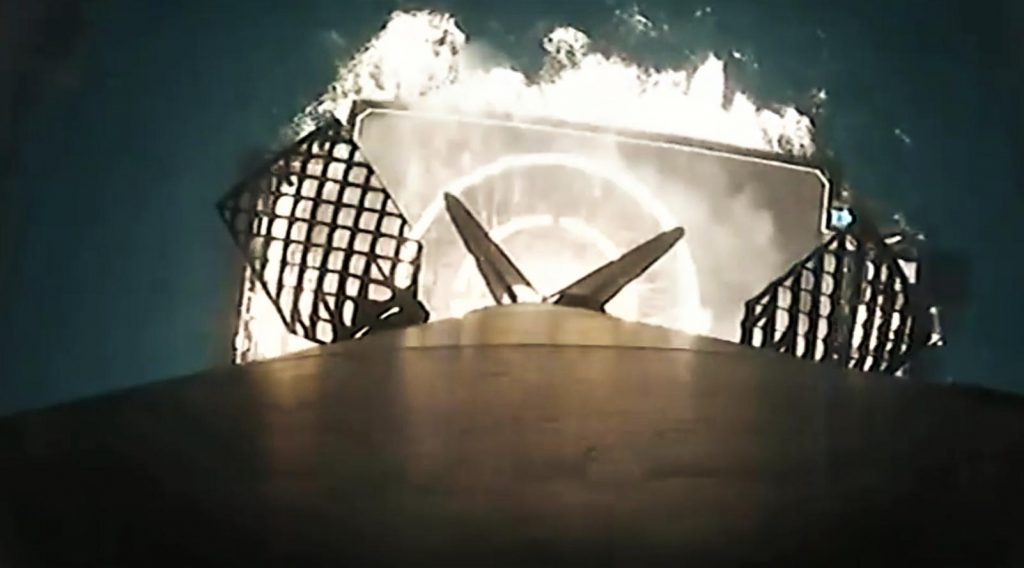

News
SpaceX's next rocket launch on track to break a 20-month-old booster reusability record
Scheduled as early as next week, SpaceX’s next rocket launch could see the company break a 20-month-old record that is closely intertwined with the reusability of its Falcon 9 and Falcon Heavy boosters.
Unsurprisingly, that record – if broken – will tag along on one of up to two dozen Starlink satellite launches SpaceX has planned for 2020. The fourth launch of upgraded Starlink v1.0 satellites and fifth dedicated launch overall, SpaceX’s next Starlink mission – deemed Starlink V1 L4 – is currently set to lift off no earlier than (NET) 10:46 am EST (15:46 UTC) on February 15th. As usual, the mission’s Falcon 9 booster will attempt to land aboard drone ship Of Course I Still Love You (OCISLY), while SpaceX recovery ships Ms. Tree and Ms. Chief may attempt to catch both Falcon payload fairing halves for the third time ever.
According to Next Spaceflight, SpaceX has assigned thrice-flown Falcon 9 booster B1056 to the Starlink launch, potentially making it the fourth SpaceX rocket to complete four separate launches. However, while SpaceX’s fourth fourth-flight milestone is significant, B1056 is – barring delays – also set to break a record that could be even more important for rocket reusability.

SpaceX’s 10th finished Falcon 9 Block 5 booster, B1056 completed a flawless launch and landing debut on May 4th, 2019, sending Cargo Dragon on its way to orbit for CRS-17, the spacecraft’s 17th International Space Station (ISS) resupply mission. Instead of a more normal return-to-launch-site (RTLS) recovery at SpaceX’s Cape Canaveral-based Landing Zone, SpaceX opted to land the booster on drone ship OCISLY.

It’s believed that SpaceX and NASA made that decision out of an abundance of caution after an attempted LZ recovery following the Falcon 9 B1050’s CRS-16 Cargo Dragon launch saw the booster lose control and crash-land in the Atlantic Ocean less than a mile off the coast.
Regardless, SpaceX’s subsequent CRS-17 Cargo Dragon launch went exactly as planned and Falcon 9 B1056 landed smoothly aboard drone ship OCISLY. Less than two days after returning to Port Canaveral, B1056 even became the first SpaceX booster to have its landing legs retracted – a small but significant step along the path to true airplane-like reusability. 82 days later, B1056 successfully completed its second launch, sending another Cargo Dragon its CRS-18 resupply mission before landing at LZ-1. The booster completed its third mission a bit less than five months later, placing the 6800 kg (15,000 lb) Kacific-1 communications satellite into geostationary transfer orbit (GTO) on December 16th, 2019.


Now, SpaceX wants to launch B1056 for the fourth time as early as February 15th. Close observers will note that that would imply just 61 days between B1056’s Kacific-1 and Starlink V1 L4 launches, a feat that would make it SpaceX’s fastest ‘booster turnaround’ ever. Currently, that record stands at 71 days and was actually achieved just a month after SpaceX debuted Falcon 9’s reusability-focused Block 5 upgrade. However, that record turnaround was actually achieved by the B1045, SpaceX’s last Falcon 9 Block 4 booster.
Surprisingly, the closest SpaceX’s upgraded Block 5 rockets have gotten to beating B1045’s 71-day record was when the company turned around Falcon Heavy side boosters B1052 and B1053 in just 74 days before completing the giant rocket’s third orbital launch since February 2018. Now, barring calamities worthy of a ten-day delay, it looks likely that Falcon 9 booster B1056 will beat out the current record-holder by up to ten days (~15%).
According to a SpaceX engineer’s January 2020 presentation, SpaceX is currently capable of landing, refurbishing, and relaunching Falcon 9 and Falcon Heavy boosters in about a month (~30 days). With Falcon 9 B1056’s Starlink V1 L4 launch, SpaceX will hopefully be taking its biggest step in 20 months towards the goal of reusing Falcon boosters in a matter of days.
Check out Teslarati’s Marketplace! We offer Tesla accessories, including for the Tesla Cybertruck and Tesla Model 3.

Investor's Corner
Tesla gets price target bump, citing growing lead in self-driving

Tesla (NASDAQ: TSLA) stock received a price target update from Pierre Ferragu of Wall Street firm New Street Research, citing the company’s growing lead in self-driving and autonomy.
On Tuesday, Ferragu bumped his price target from $520 to $600, stating that the consensus from the Consumer Electronics Show in Las Vegas was that Tesla’s lead in autonomy has been sustained, is growing, and sits at a multiple-year lead over its competitors.
CES 2026 validates Tesla’s FSD strategy, but there’s a big lag for rivals: analyst
“The signal from Vegas is loud and clear,” the analyst writes. “The industry isn’t catching up to Tesla; it is actively validating Tesla’s strategy…just with a 12-year lag.”
The note shows that the company’s prowess in vehicle autonomy is being solidified by lagging competitors that claim to have the best method. The only problem is that Tesla’s Vision-based approach, which it adopted back in 2022 with the Model 3 and Model Y initially, has been proven to be more effective than competitors’ approach, which utilizes other technology, such as LiDAR and sensors.
Currently, Tesla shares are sitting at around $433, as the company’s stock price closed at $432.96 on Tuesday afternoon.
Ferragu’s consensus on Tesla shares echoes that of other Wall Street analysts who are bullish on the company’s stock and position within the AI, autonomy, and robotics sector.
Dan Ives of Wedbush wrote in a note in mid-December that he anticipates Tesla having a massive 2026, and could reach a $3 trillion valuation this year, especially with the “AI chapter” taking hold of the narrative at the company.
Ives also said that the big step in the right direction for Tesla will be initiating production of the Cybercab, as well as expanding on the Robotaxi program through the next 12 months:
“…as full-scale volume production begins with the autonomous and robotics roadmap…The company has started to test the all-important Cybercab in Austin over the past few weeks, which is an incremental step towards launching in 2026 with important volume production of Cybercabs starting in April/May, which remains the golden goose in unlocking TSLA’s AI valuation.”
Tesla analyst breaks down delivery report: ‘A step in the right direction’
Tesla has transitioned from an automaker to a full-fledged AI company, and its Robotaxi and Cybercab programs, fueled by the Full Self-Driving suite, are leading the charge moving forward. In 2026, there are major goals the company has outlined. The first is removing Safety Drivers from vehicles in Austin, Texas, one of the areas where it operates a ride-hailing service within the U.S.
Ultimately, Tesla will aim to launch a Level 5 autonomy suite to the public in the coming years.
Elon Musk
Elon Musk’s Biggest Revelations on AI, Robots, and the Future of Work from the Moonshots Podcast

Elon Musk’s appearance on the Moonshots with Peter Diamandis podcast was packed with bold predictions, candid admissions, and surprising tech insights. The nearly three-hour conversation covered everything from artificial intelligence to humanoid robots, geopolitics, and the future of work. Here are the top 10 most intriguing takeaways:
-
Aggressive AGI Timeline Predictions
Musk offered a detailed view on when artificial general intelligence (AGI) could emerge, suggesting it may arrive sooner than many expect, emphasizing both transformative potential and risks.
-
U.S. vs. China in the AI Race
He discussed the strategic competition between the United States and China over AI development, noting that geopolitical dynamics will shape how and who leads in the next decades.
-
Future of Job Markets
Musk touched on how AI and automation could reshape employment, predicting massive boosts in productivity alongside potential disruptions in traditional work structures.
-
Clean Energy Transition
A recurring theme was the role of clean energy in future economies, with Musk reiterating the importance of scaling sustainable power generation and storage.
-
Humanoid Robots Are Coming
On the podcast, Musk elaborated on Tesla’s work on humanoid robots, hinting at timelines and applications that go beyond factories to general-purpose assistance.
-
Tesla Roadster “Last Human-Driven Car”
Outside the core discussion topics, Musk teased features of the upcoming Tesla Roadster — calling it “the best of the last of the human-driven cars” and suggesting safety won’t be its main selling point.
-
The Role of AI in Clean Energy and Robotics
Linking AI to both energy optimization and robotics, Musk explained how smarter systems could accelerate decarbonization and task automation across industries.
-
U.S. Innovation Leadership
Musk argued that maintaining American leadership in key tech sectors like AI, space, and robotics should be a national priority, with thoughtful policy and investment.
-
Job Creation vs. Job Elimination
While acknowledging automation’s disruptive effects, he also outlined scenarios where new industries and opportunities could emerge, particularly in AI, space, and advanced manufacturing.
-
Long-Term Vision for Humanity
Throughout the conversation, Musk revisited his long-term philosophical views — including a belief in humanity’s responsibility to become a multi-planetary and technologically empowered species.
Whether you agree with Musk’s optimism or not, the podcast offers a window into the thinking of one of the most influential figures in tech today, in and why his visions continue to spark debate and inspiration.
Elon Musk
Elon Musk just said some crazy stuff about the Tesla Roadster

Elon Musk appeared on the Moonshots podcast with Peter Diamandis today to discuss AGI, U.S. vs. China, Tesla, and some other interesting topics, but there was some discussion about the upcoming unveiling of the Roadster, the company’s electric supercar that will arrive several years after it was initially slated for release.
Musk made some pretty amazing claims about the Roadster; we already know it is supposed to be lightning-fast and could even hover, if Tesla gets everything to happen the way it wants to. However, the car has some pretty crazy capabilities, some of which have not even been revealed.
On the podcast, Musk said:
“This is not a…safety is not the main goal. If you buy a Ferrari, safety is not the number one goal. I say, if safety is your number one goal, do not buy the Roadster…We’ll aspire not to kill anyone in this car. It’ll be the best of the last of the human-driven cars. The best of the last.”
🚨 Elon on the Roadster unveiling, scheduled for April 1:
— TESLARATI (@Teslarati) January 6, 2026
Musk makes a good point: people who buy expensive sports cars with ridiculous top speeds and acceleration rates do not buy them to be safe. They hope they are safe in case of an emergency or crash, but safety is not at the forefront of their thoughts, because nobody buys a car thinking they’ll crash it.
The Roadster is truly going to push the limits and capabilities of passenger vehicles; there’s no doubt about that. Tesla plans to show off the new version car for the first time on April 1, and Musk has only hinted at what is possible with it.
Musk said back in November:
“Whether it’s good or bad, it will be unforgettable. My friend Peter Thiel once reflected that the future was supposed to have flying cars, but we don’t have flying cars. I think if Peter wants a flying car, he should be able to buy one…I think it has a shot at being the most memorable product unveiling ever. [It will be unveiled] hopefully before the end of the year. You know, we need to make sure that it works. This is some crazy technology in this car. Let’s just put it this way: if you took all the James Bond cars and combined them, it’s crazier than that.”
Production is set to begin between 12 and 18 months after the unveiling, which would put the car out sometime in 2027. Hopefully, Tesla is able to stay on track with the scheduling of the Roadster; many people have been waiting a long time for it.








